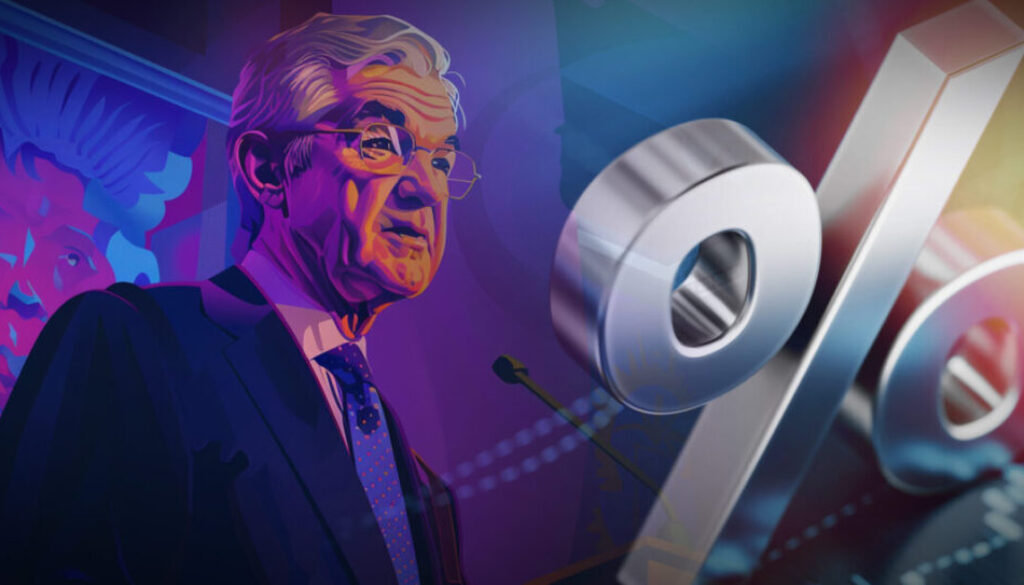Fed unlikely to make rate cuts soon, says Powell
Don’t look for interest rate reductions any time soon.
Federal Reserve Chairman Jerome Powell said Wednesday he and his colleagues need more time and more evidence of an improving economy before they will likely cut rates.
“We do not expect that it will be appropriate to lower our policy rate until we have greater confidence that inflation is moving sustainably down toward 2%,” Powell said in Business, Government, and Society Forum sponsored by the Stanford University Graduate School of Business. “We have time to let the incoming data guide our decisions.”
That said, Powell reiterated that Fed’s Open Market Committee has maintained current rate policies since July, with projections suggesting they may be at their peak.
Rate cuts may be considered ‘later in the year’
“If economic conditions align with expectations, the committee anticipates considering rate reductions later in the year,” he said. “Reducing rates too soon or too much could result in a reversal of the progress we’ve seen on inflation, and ultimately require even tighter policy to get inflation back to 2%.”
But easing policy too late or too little could unduly weaken economic activity and employment, he said, as progress on inflation continues and labor market tightness eases, these risks continue to move into better balance. Despite lingering uncertainties, however, Powell pointed to a much improved and improving state of the economy.
Over the past year, he noted, inflation has moderated but remains still above the Fed’s 2% target. He said headline inflation stood at 2.5% in February based on the Personal Consumption Expenditures (PCE) index, down from 4.8% a year ago.
“While this represents significant progress, sustaining 2% inflation remains a priority,” he said.
Despite tight monetary policy dampening demand, economic growth and employment have remained robust. Real GDP expanded by more than 3% in 2023, with 3 million jobs created, even as inflation declined. Powell attributed this to improvements in supply chains and labor markets, including increased participation among prime-age workers and strong immigration rates.
Job gains, inflation cuts surpass expectations
Both job gains and inflation have surpassed expectations, he said, with the economy adding an average of 265,000 jobs per month.
Overall, Powell emphasized that the economic data points show a picture of solid growth, a strong labor market, and inflation gradually moving towards 2%.
Powell clung to the Fed’s dual mandate of maximum employment and stable prices, emphasizing the importance of independence in policy decisions. He highlighted the Fed’s commitment to transparency, accountability, and technical competence in guiding monetary policy. He said he adheres to a need to continually earn public trust by delivering on assigned goals with objectivity and integrity.
Powell reaffirmed the Fed’s commitment to its mandate, emphasizing the importance of respecting the boundaries of its authority while maintaining public trust. As economic conditions evolve, the Fed remains poised to adapt its monetary policy to achieve maximum employment and price stability.
Looking back over the last several years, Powell said factors driving inflation were different than what the nation saw in previous inflationary periods.
‘Demand overheating’ drove inflation
“What was actually different this time is that it wasn’t just a question of demand overheating and the Fed coming in and having to suppress demand,” he said. “That’s been the typical pattern, perhaps on the back of a shock such as the oil price shock and that kind of thing.”
This time, he said inflation rose on the collapse of the supply side.
“Supply chains stopped working,” he said. “There was a shortage of critical things like semiconductors that led to a major labor force shock. We had a very severe labor shock. So it was a supply side issue as well as overheated demand from the closing and then reopening of the economy at a time when when rates were low and fiscal policy was very supportive of demand. So we had both the unwinding of the pandemic related distortions in both the
supply and demand in the economy and also the effects of tight monetary policy.”
Powell’s remarks underscored the delicate balance between supporting economic growth and addressing inflationary pressures, signaling the Fed’s cautious approach to policy adjustments in the coming months. Because of the unusual origins of the most recent inflationary period, and its differences from prior episodes, there was a path to getting inflation down, restoring price stability, without the kind of large job losses and increases in unemployment that
had been typical of prior tightening cycles.
“You couldn’t buy a car at the very time when people wanted cars because they were moving to the suburbs, because they didn’t want to ride on public transportation because of COVID,” he said. “At that precise time, the supply of cars went down dramatically because of the shortage. So what happened is the prices went way up. That’s how the market clutters in our economy.”
Doug Bailey is a journalist and freelance writer who lives outside of Boston. He can be reached at doug.bailey@innfeedback.com.
© Entire contents copyright 2024 by InsuranceNewsNet.com Inc. All rights reserved. No part of this article may be reprinted without the expressed written consent from InsuranceNewsNet.com.
The post Fed unlikely to make rate cuts soon, says Powell appeared first on Insurance News | InsuranceNewsNet.




